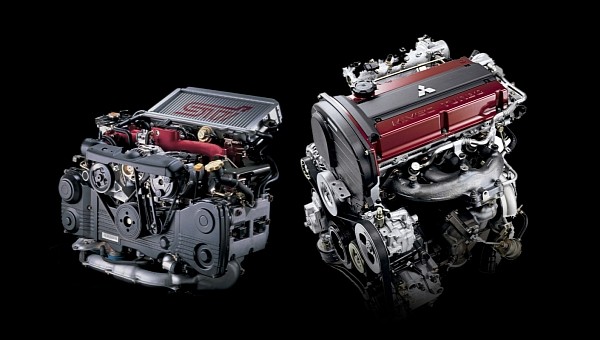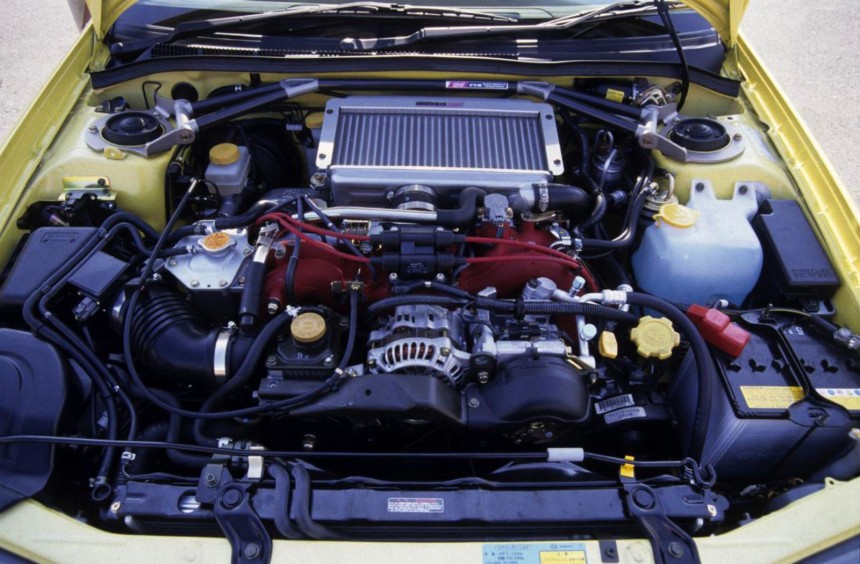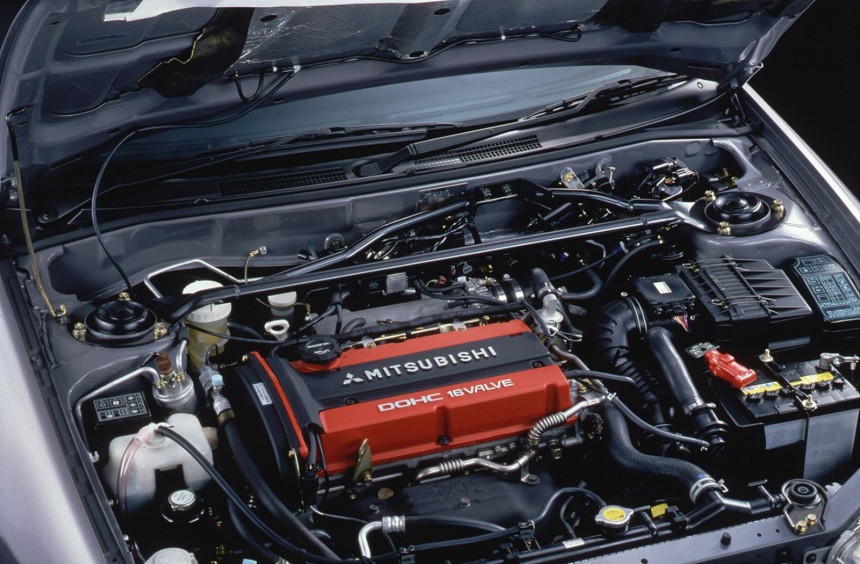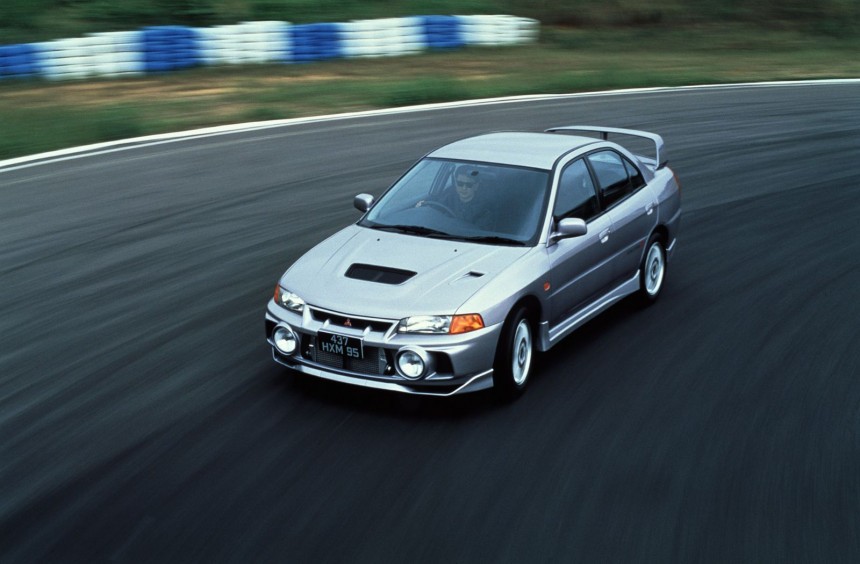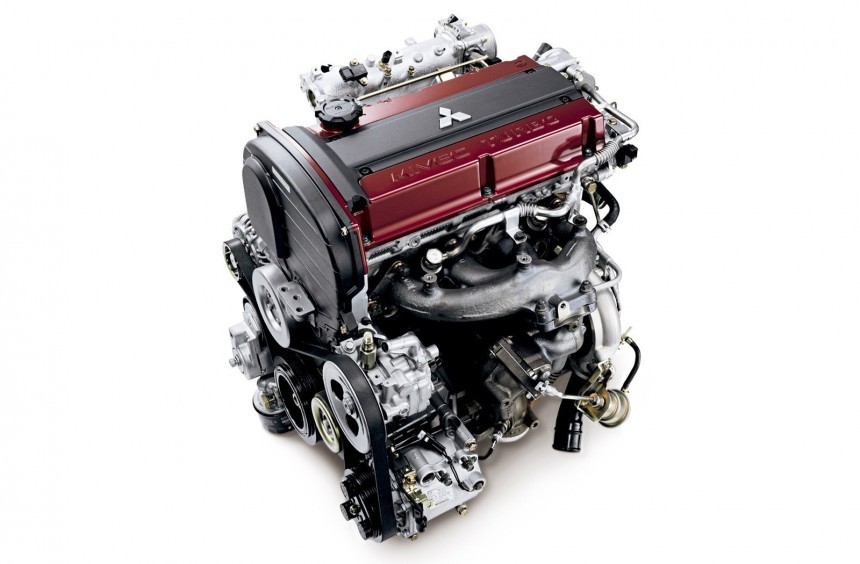Although they powered various Subaru or Mitsubishi models, these Japanese four-cylinder rivals became legendary in the engine bays of the rally-bred WRX STI and Lancer Evolution cars.
When it comes to legendary engines, large units with eight cylinders or more are usually the most talked about. But, throughout the last five decades, many carmakers have proven that smaller-displacement, four-cylinder powerplants can be just as exciting.
Some of the most impressive fours were born in Japan, a country where Honda, Nissan, Toyota, Subaru, and Mitsubishi turned ordinary engines meant for mundane vehicles into high-performance engineering works of art.
Arguably the most famous Japanese four-pots of all time are the Subaru EJ20 and the Mitsubishi 4G63T, two amazing engines that powered multiple generations of iconic rally cars, as well as their road-legal counterparts.
Since the WRX STI and Evolution models have always been fierce rivals in the World Rally Championship (WRC) and on public roads, enthusiasts have always debated which had the better engine. So, without further ado, let’s take an in-depth look at both and attempt to answer this question.
Introduced in 1989, the engine series dubbed EJ powered most of Subaru’s models for the next thirty years. Although a large number of variants with different displacements have been built, some of the most famous were the 2.0-liter, turbocharged EJ20s, which debuted in the first-generation Legacy, then became legendary in the Impreza WRX STI models under the codenames EJ20G, EJ20K, EJ205, and EJ207. While Subaru’s designations can be overwhelmingly confusing, the turbocharged WRX STI versions that we're going to focus on are all generally known as EJ20s.
Like the entire EK engine family, the EJ20 was a 16-valve, flat-four boxer. Although this configuration is less common in the automotive industry today due to its complexity, Subaru and Porsche still use it because it delivers a low center of gravity, a shorter engine package, and produces less vibration than an inline-four.
The block was made out of aluminum and, depending on the model year, it employed either a closed or open deck design with cast-iron cylinder liners and five main bearings. The conrods were mostly forged, while the pistons were either forged or hypereutectic. Connected to the block were two aluminum cylinder heads, each featuring two cams with four valves per cylinder.
It’s also worth noting that the US-spec, as well as some Euro WRX STi models, came with engines codenamed EJ25. These were larger displacement, 2,5-liter units based on the EJ20.
Like its Japanese rival, the 4G63T was born in the 1980s, but debuted nine years earlier under the hood of the Lancer EX 2000 Turbo. Over the next decade, it was used in various Mitsubishi models like the Starion or Eclipse and their North American, badge-engineered derivatives, but it became an icon for powering the first nine generations of the Lancer Evolution.
This engine was a straight-four and, unlike Subaru’s confusing designations, it was codenamed 4G63 throughout its lifespan, regardless of how many revisions it received and whether it was naturally aspirated or turbocharged. Still, to differentiate the turbocharged versions, the 4G63T moniker was (and still is) often used.
It was built around a cast-iron block which was heavier than the EJ20’s aluminum unit, but the material choice and the beefy design made it virtually bombproof. The same can be said about the fully counterweighted forged steel crankshaft that was overengineered with unparalleled reliability in mind. Since this engine was also continually revised throughout the years, the materials used for the conrods vary, but all iterations used cast iron pistons.
Up top, the cylinder head was made of aluminum and evolved from 8-valve, SOHC (found in the EX2000 Turbo) to 16-valve DOHC, with the newest versions (2005 to 2007) employing Mitsubishi's variable valve timing technology called MIVEC.
Since both power plants appeared during the 1980s and had to cope with increasing emission restrictions in the decades that followed, stock output was by no means mind-blowing.
The first Subaru Impreza WRX STi introduced in 1994 came with a turbocharged EJ20 that could produce 247 hp (250 ps) and 228 lb-ft (309 Nm). The most powerful stock version of the engine came in 2019 in the JDM WRX STI EJ20 Final Edition, where it made 309 hp (313 ps) and 311 lb-ft (422 Nm) of torque.
Mitsubishi launched the first Lancer Evolution in 1994 and its 4G63T was rated at 244 hp (247 ps) and 228 lb-ft (309 Nm) of torque. These figures rose with each generation, reaching 287 hp (291 ps) and 300 lb-ft (407 Nm) of torque in the 2005-2007 Evo IX RS and GT. However, a limited-edition Evo IX, marketed exclusively in the United Kingdom as FQ-400, featured a heavily-tuned 4G63T that spit out no less than 405 hp (410 ps) and 355 lb-ft (481 Nm) of torque.
Both the WRX STI and the Lancer Evolution rose to fame for their motorsport endeavors, dominating the rally scene during the second half of the 1990s.
Competing with Impreza WRX STI rally cars equipped with modified EJ20s that produced over 300 hp (304 ps), Subaru won the manufacturers’ title three times in a row (1995-1997), as well as three drivers’ titles, in 1995 (Colin McRae), 2001 (Richard Burns), and 2003 (Petter Solberg).
Mitsubishi and its 4G63T-powered Evolution rally cars only managed to snag one manufacturers’ trophy in 1997, but their number one factory driver, Tommi Mäkinen, won the driver’s title during four consecutive seasons (1996 to 1999).
As I mentioned before, the EJ20 is a flat-four, so it has two cylinder heads. Obviously, that makes it more complex than a classic inline-four, but in terms of reliability, it’s a solid engine. That said, it has its shortcomings, with common problems including high oil consumption, oil leaks, or knocking in the 4th cylinder due to the debatable design of the cooling system.
The 4G63T, with its cast iron block and sturdy internals, is less complex and thus, generally more reliable. Still, it also has its issues, which range from failing lifters and weak balance shaft bearing to a head gasket susceptible to premature wear.
But, when it comes to tuning, the 4G63T's old-school architecture makes it easier to extract massive amounts of power, which is why it’s one of the most often-modified engines out there. With slight "plug and play" mods that don’t require replacing any of the internals, around 400 hp (405.7 ps) can be easily achieved. On the opposite spectrum, extensive modifications like a bigger turbo, forged internals, and race cams will enable the 2.0-liter to go past the 800 hp (811.4 ps) mark.
Because of its boxer design, the EJ is a bit more complicated to modify and it has a habit of blowing up if the tuning isn’t done right. Minor modifications that don’t include swapping the internals won’t yield more than 400-450 hp (405.7-456 ps), but with more extensive tuning that includes a bigger, rerouted turbo, stronger internals, and more aggressive cams, about 600 hp (608.5 ps) can be attained with the stock aluminum block. Anything past that threshold will require an aftermarket block.
There’s no question that both engines are not just good, but legendary. Each proved that in the awesome street-legal machines and the winning rally cars that they powered.
Although I have always been a huge fan of the Lancer Evolution models, I consider the boxer architecture of the EJ20 to be far more fascinating. It’s one of the very few flat engines that survived in the automotive industry well into the 21st century and, unlike a Porsche unit, it’s cheaper to source and maintain.
But, since I must be objective, the 4G63T, with its bombproof block, increased reliability, superior power potential, and ease of tuning, is, undeniably, the better engine. It’s generally less powerful in stock form, but that’s only because it was discontinued in 2007, while high-performance versions of the EJ20 continued to be developed until 2019.
Some of the most impressive fours were born in Japan, a country where Honda, Nissan, Toyota, Subaru, and Mitsubishi turned ordinary engines meant for mundane vehicles into high-performance engineering works of art.
Arguably the most famous Japanese four-pots of all time are the Subaru EJ20 and the Mitsubishi 4G63T, two amazing engines that powered multiple generations of iconic rally cars, as well as their road-legal counterparts.
Since the WRX STI and Evolution models have always been fierce rivals in the World Rally Championship (WRC) and on public roads, enthusiasts have always debated which had the better engine. So, without further ado, let’s take an in-depth look at both and attempt to answer this question.
Subaru EJ20: Short history and architecture
Like the entire EK engine family, the EJ20 was a 16-valve, flat-four boxer. Although this configuration is less common in the automotive industry today due to its complexity, Subaru and Porsche still use it because it delivers a low center of gravity, a shorter engine package, and produces less vibration than an inline-four.
The block was made out of aluminum and, depending on the model year, it employed either a closed or open deck design with cast-iron cylinder liners and five main bearings. The conrods were mostly forged, while the pistons were either forged or hypereutectic. Connected to the block were two aluminum cylinder heads, each featuring two cams with four valves per cylinder.
It’s also worth noting that the US-spec, as well as some Euro WRX STi models, came with engines codenamed EJ25. These were larger displacement, 2,5-liter units based on the EJ20.
Mitsubishi 4G63T: Short history and architecture
This engine was a straight-four and, unlike Subaru’s confusing designations, it was codenamed 4G63 throughout its lifespan, regardless of how many revisions it received and whether it was naturally aspirated or turbocharged. Still, to differentiate the turbocharged versions, the 4G63T moniker was (and still is) often used.
It was built around a cast-iron block which was heavier than the EJ20’s aluminum unit, but the material choice and the beefy design made it virtually bombproof. The same can be said about the fully counterweighted forged steel crankshaft that was overengineered with unparalleled reliability in mind. Since this engine was also continually revised throughout the years, the materials used for the conrods vary, but all iterations used cast iron pistons.
Up top, the cylinder head was made of aluminum and evolved from 8-valve, SOHC (found in the EX2000 Turbo) to 16-valve DOHC, with the newest versions (2005 to 2007) employing Mitsubishi's variable valve timing technology called MIVEC.
Stock horsepower and torque
The first Subaru Impreza WRX STi introduced in 1994 came with a turbocharged EJ20 that could produce 247 hp (250 ps) and 228 lb-ft (309 Nm). The most powerful stock version of the engine came in 2019 in the JDM WRX STI EJ20 Final Edition, where it made 309 hp (313 ps) and 311 lb-ft (422 Nm) of torque.
Mitsubishi launched the first Lancer Evolution in 1994 and its 4G63T was rated at 244 hp (247 ps) and 228 lb-ft (309 Nm) of torque. These figures rose with each generation, reaching 287 hp (291 ps) and 300 lb-ft (407 Nm) of torque in the 2005-2007 Evo IX RS and GT. However, a limited-edition Evo IX, marketed exclusively in the United Kingdom as FQ-400, featured a heavily-tuned 4G63T that spit out no less than 405 hp (410 ps) and 355 lb-ft (481 Nm) of torque.
Motorsport heritage
Competing with Impreza WRX STI rally cars equipped with modified EJ20s that produced over 300 hp (304 ps), Subaru won the manufacturers’ title three times in a row (1995-1997), as well as three drivers’ titles, in 1995 (Colin McRae), 2001 (Richard Burns), and 2003 (Petter Solberg).
Mitsubishi and its 4G63T-powered Evolution rally cars only managed to snag one manufacturers’ trophy in 1997, but their number one factory driver, Tommi Mäkinen, won the driver’s title during four consecutive seasons (1996 to 1999).
Reliability and tuning potential
The 4G63T, with its cast iron block and sturdy internals, is less complex and thus, generally more reliable. Still, it also has its issues, which range from failing lifters and weak balance shaft bearing to a head gasket susceptible to premature wear.
But, when it comes to tuning, the 4G63T's old-school architecture makes it easier to extract massive amounts of power, which is why it’s one of the most often-modified engines out there. With slight "plug and play" mods that don’t require replacing any of the internals, around 400 hp (405.7 ps) can be easily achieved. On the opposite spectrum, extensive modifications like a bigger turbo, forged internals, and race cams will enable the 2.0-liter to go past the 800 hp (811.4 ps) mark.
Because of its boxer design, the EJ is a bit more complicated to modify and it has a habit of blowing up if the tuning isn’t done right. Minor modifications that don’t include swapping the internals won’t yield more than 400-450 hp (405.7-456 ps), but with more extensive tuning that includes a bigger, rerouted turbo, stronger internals, and more aggressive cams, about 600 hp (608.5 ps) can be attained with the stock aluminum block. Anything past that threshold will require an aftermarket block.
The verdict
Although I have always been a huge fan of the Lancer Evolution models, I consider the boxer architecture of the EJ20 to be far more fascinating. It’s one of the very few flat engines that survived in the automotive industry well into the 21st century and, unlike a Porsche unit, it’s cheaper to source and maintain.
But, since I must be objective, the 4G63T, with its bombproof block, increased reliability, superior power potential, and ease of tuning, is, undeniably, the better engine. It’s generally less powerful in stock form, but that’s only because it was discontinued in 2007, while high-performance versions of the EJ20 continued to be developed until 2019.
